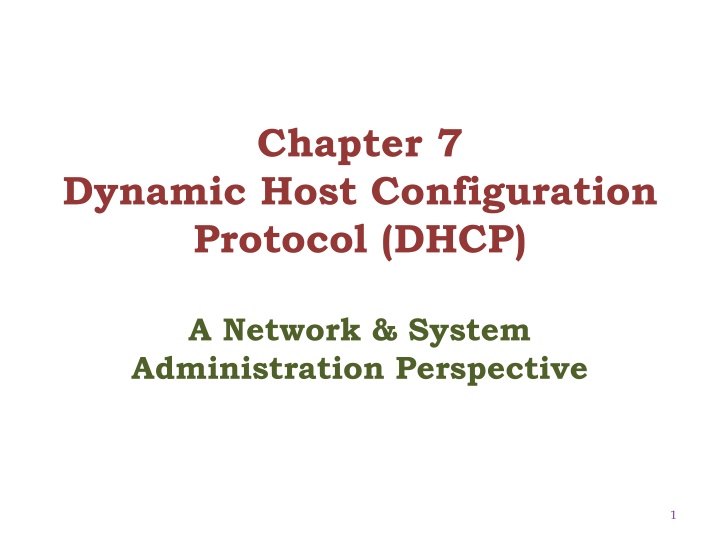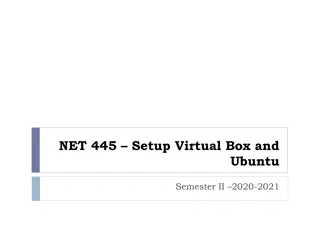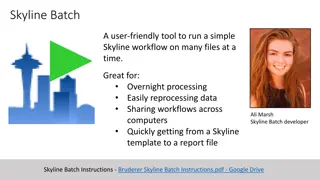DHCP Configuration Guidelines for Ubuntu Systems
Learn about Dynamic Host Configuration Protocol (DHCP) and how to configure DHCP server on Ubuntu systems. Understand the automatic assignment of network settings and the steps involved in DHCP server configuration. Explore DHCP configuration properties and advantages. Discover how DHCP works, including manual and dynamic allocation methods. Get insights into DHCP server installation on Ubuntu and common configuration settings.
Download Presentation

Please find below an Image/Link to download the presentation.
The content on the website is provided AS IS for your information and personal use only. It may not be sold, licensed, or shared on other websites without obtaining consent from the author.If you encounter any issues during the download, it is possible that the publisher has removed the file from their server.
You are allowed to download the files provided on this website for personal or commercial use, subject to the condition that they are used lawfully. All files are the property of their respective owners.
The content on the website is provided AS IS for your information and personal use only. It may not be sold, licensed, or shared on other websites without obtaining consent from the author.
E N D
Presentation Transcript
Chapter 7 Dynamic Host Configuration Protocol (DHCP) A Network & System Administration Perspective 1
Introduction DHCP is s a network service that enables host computers to be automatically assigned settings from a server. Computers configured to be DHCP clients have no control over the settings they receive from the DHCP server. The configuration is transparent to the computer's user. The most common settings provided by a DHCP server to DHCP clients include: IP address and Subnet Mask IP address of the default-gateway to use IP addresses of the DNS servers to use 2 CS Dept @AmboU Network and System Administration
Introduction However, a DHCP server can also supply configuration properties such as: Host Name: Eg. www, mail, Domain Name: Eg. ambou.edu.et, aau.edu.et Time Server: ntp Print Server Advantages of using DHCP includes: Changes to the network need only be changed at the DHCP server. It is also easier to integrate new computers into the network. Conflicts in IP address allocation are also reduced. 3 CS Dept @AmboU Network and System Administration
How DHCP works? Manual allocation (MAC address) Using DHCP to identify the unique hardware address of each network card connected to the network. Continually supplying a constant configuration each time the DHCP client makes a request to the DHCP server using that network device. This ensures that a particular address is assigned automatically to that network card, based on it's MAC address. Dynamic allocation (address pool) The DHCP server will assign an IP address from a pool of addresses (sometimes also called a range or scope) for a period of time or lease. This way, the clients will be receiving their configuration properties dynamically and on a "first come, first served basis CS Dept @AmboU Network and System Administration 4
How DHCP works. When a DHCP client is no longer on the network for a specified period, the configuration is expired and released back to the address pool for use by other DHCP Clients. Automatic allocation The DHCP automatically assigns an IP address permanently to a device, selecting it from a pool of available addresses. DHCP is used to assign a temporary address to a client, but a DHCP server can allow an infinite lease time. 5 CS Dept @AmboU Network and System Administration
DHCP Server Configuration DHCP Server configuration on ubuntu follows the following steps: Installation of the dhcp service (dhcpd) sudo apt-get install isc-dhcp-server Note: Edit the /etc/dhcp/dhcp.conf file to change the default confituration. Configuration Most commonly, what you want to do is assign an IP address randomly. This can be done with settings as follows: # minimal sample /etc/dhcp/dhcpd.conf default-lease-time 600; max-lease-time 7200; subnet 192.168.1.0 netmask 255.255.255.0 { range 192.168.1.150 192.168.1.200; option routers 192.168.1.254; option domain-name-servers 192.168.1.1, 192.168.1.2; option domain-name "mydomain.example"; } 6 CS Dept @AmboU Network and System Administration
Configuration. This will result in the DHCP server giving clients an IP address from the range 192.168.1.150-192.168.1.200. It will lease an IP address for 600 seconds if the client doesn't ask for a specific time frame. Otherwise the maximum (allowed) lease will be 7200 seconds. The server will also "advise" the client to use 192.168.1.254 as the default-gateway 192.168.1.1 and 192.168.1.2 as its DNS servers. After changing the config file you have to restart the dhcpd: sudo /etc/init.d/isc-dhcp-server restart 7 CS Dept @AmboU Network and System Administration
Name Server and Configuration The Domain Name System (DNS) is a distributed database. This allows local control of the segments of the overall database, yet the data in each segment is available across the entire network through a client-server scheme. DNS's distributed database is indexed by domain names. Each domain name is essentially just a path in a large inverted tree, called the domain name space. DNS's tree can branch any number of ways at each intersection point, or node. 8 CS Dept @AmboU Network and System Administration
Name Server The depth of the tree is limited to 127 levels. Each node in the tree has a text label (without dots) that can be up to 63 characters long. A null (zero-length) label is reserved for the root. Domain names are always read from the node toward the root, with dots separating the names in the path. When the root node's label appears by itself, it is written as a single dot (.) for convenience. 9 CS Dept @AmboU Network and System Administration
Name Server DNS requires that sibling nodes have different labels. Restriction guarantees that a domain name uniquely identifies a single node in the tree. 10 CS Dept @AmboU Network and System Administration
Name Server The domain name of a domain is the same as the domain name of the node at the very top of the domain. So for example, the top of the purdue.edu domain is a node named purdue.edu 11 CS Dept @AmboU Network and System Administration
Name Server Any domain name in the subtree is considered a part of the domain. Because a domain name can be in many subtrees, it can also be in many domains. For example, the domain name pa.ca.us is part of the ca.us domain and also part of the us domain 12 CS Dept @AmboU Network and System Administration
Internet Domain Name Space The original top-level domains divided the Internet domain name space organizationally into seven domains: com Commercial organizations, such as Hewlett-Packard (hp.com), Sun Microsystems (sun.com), and IBM (ibm.com). edu Educational organizations, such as Ambo University (ambou.edu) and Purdue University (purdue.edu). gov Government organizations, such as INSA (insa.gov) and the Ministry of Foreign Affairs (mfa.gov). mil Military organizations, such as the U.S. Army (army.mil ) and Navy (navy.mil ). net Organizations providing network infrastructure, such as EthioTelecom (ethiotelecom.net) and UUNET (uu.net). org Formerly, noncommercial organizations, such as the Electronic Frontier Foundation (eff.org ). Like net, however, restrictions on org were removed in 1996. int International organizations, such as NATO (nato.int). 13 CS Dept @AmboU Network and System Administration
Delegation Decentralize administration in DNS is achieved through delegation. An organization administering a domain can divide it into subdomains. Each of those subdomains can be delegated to other organizations. An organization becomes responsible for maintaining all the data in that subdomain. It can freely change the data, and even divide up its subdomain into more subdomains and delegate those. 14 CS Dept @AmboU Network and System Administration
Delegation Not all organizations delegate away their whole domain. A domain may have several delegated subdomains and also contain hosts that don't belong in the subdomains. For example, the Ambo University has a campus at Awaro and Woliso. So it might have a awaro.ambou.edu.et subdomain and a woliso.ambou.edu.et subdomain. 15 CS Dept @AmboU Network and System Administration
Name Servers and Zones The programs that store information about the domain name space are called name servers. Name servers generally have complete information about some part of the domain name space (a zone), which they load from a file or from another name server. The other name server is called Forwarder. The name server is then said to have authority for that zone. Name servers can be authoritative for multiple zones, too. 16 CS Dept @AmboU Network and System Administration
Zones All top-level domains, and many domains at the second level and lower, such as berkeley.edu and hp.com, are broken into smaller, more manageable units by delegation. These units are called zones. 17 CS Dept @AmboU Network and System Administration
Zone Data Files Most entries in zone data files are called DNS resource records. DNS lookups are case-insensitive, so you can enter names in your zone data files in uppercase, lowercase, or mixed case. Commonly all lowercase is used. 18 CS Dept @AmboU Network and System Administration
Types of DNS Resource Records SOA record Indicates authority for this zone (Start Of Authority) NS record Lists a name server for this zone Arecord Name-to-address mapping PTR records Address-to-name mapping CNAME records Canonical name (for aliases) MX records Records for Mail Exchange server 19 CS Dept @AmboU Network and System Administration
Example ; ; NS Record; ambou.edu.et. ambou.edu.et. ;; Mail Exchange ambou.edu.et. ;;A Records intranet.ambou.edu.et. medsims.ambou.edu.et. ; ; PTR Addresses 9.100.5.102.in-addr.arpa. 56.100.5.10.in-addr.arpa. ; ; Aliases medicine.ambou.edu.et. IN IN NS NS ns1.ambou.edu.et ns2.ambou.edu.et IN MX mail.ambou.edu.et IN IN A A 10.5.100.9 10.5.100.56 IN IN PTR PTR intranet.ambou.edu.et. medsims.ambou.edu.et IN CNAME medsims.ambou.edu.et. 20 CS Dept @AmboU Network and System Administration
Resolver Resolvers are the clients that access name servers. Programs running on a host that need information from the domain name space use the resolver. The resolver handles the following tasks: Querying a name server Interpreting responses (which may be resource records or an error) Returning the information to the programs that requested it 21 CS Dept @AmboU Network and System Administration
Name Space Resolution Name servers are adept at retrieving data from the domain name space. They have to be, given the limited intelligence of most resolvers. Not only can they give you data from zones for which they're authoritative, they can also search through the domain name space to find data for which they're not authoritative. This process is called name resolution or simply resolution. 22 CS Dept @AmboU Network and System Administration
Resolution Because the namespace is structured as an inverted tree, a name server needs only one piece of information to find its way to any point in the tree: The domain names and addresses of the root name servers A name server can issue a query to a root name server for any domain name in the domain name space, and the root name server starts the name server on its way. 23 CS Dept @AmboU Network and System Administration
Resolution Process 24 CS Dept @AmboU Network and System Administration
Adding More Name Servers Primary and Slave Name Servers In large networks it is a good idea to define name servers and give them authority. Primary Name Server is Authoritative Secondary Name Server is active when Primary NS fails Caching Only Name Servers The name implies that the only function this server performs is looking up data and caching it. They are not authoritative for any zones (except 0.0.127.in-addr.arpa). 25 CS Dept @AmboU Network and System Administration
BIND BIND (Berkeley Internet Name Domain) is the default name server for Linux OS. Installation and Configuration: Update your server and Install BIND on it. Execute the following commands one by one. $sudo apt-get update $sudo apt-get install bind9 bind9utils bind9-doc Before proceeding you can optionally set bind9 to IPv4 mode. $sudo nano /etc/default/bind9 Add "-4" to the OPTIONS variable. Then save and exit. It should look like the following: OPTIONS="-4 -u bind" 26 CS Dept @AmboU Network and System Administration
The End CS Dept @AmboU Network and System Administration 27























